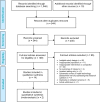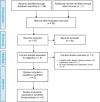Intermittent Catheters for Chronic Urinary Retention: A Health Technology Assessment
- PMID: 30847008
- PMCID: PMC6395058
Intermittent Catheters for Chronic Urinary Retention: A Health Technology Assessment
Abstract
Background: People with chronic urinary retention typically require intermittent catheterization. This review evaluates the effectiveness, safety, patient preference, cost-effectiveness, and budget impact of different types of intermittent catheter (IC). Specifically, we compared prelubricated catheters (hydrophilic, gel reservoir) and noncoated catheters, as well as their single use versus reuse (multiple use).
Methods: We performed a systematic literature search and included randomized controlled trials, cohort, and case-control studies that examined any type of single-use versus multiple-use IC, hydrophilic single-use versus noncoated single-use, or gel reservoir single-use versus noncoated single-use. The outcomes of interest were symptomatic urinary tract infection (UTI), hematuria, other serious adverse events, and patient satisfaction. The quality of the body of evidence was examined according to the Grading of Recommendations, Assessment, Development, and Evaluation (GRADE) Working Group criteria. We also completed an economic evaluation, using the perspective of the Ontario Ministry of Health and Long-Term Care, to determine the cost-effectiveness of various intermittent catheters used in Ontario. We determined the budget impact of fully and partially funding various intermittent catheters for outpatients with chronic urinary retention. To understand patient experiences with intermittent catheterization, we interviewed 34 adults and parents of children affected by chronic urinary retention.
Results: We found 14 randomized controlled trials that met the inclusion criteria. When comparing any type of single-use or multiple-use IC, we found no difference in UTI (RR = 0.98, 95% CI 0.70-1.39), hematuria, or serious adverse events, and inconclusive evidence on patient satisfaction.Our meta-analysis of studies on people living in the community showed that hydrophilic ICs may result in fewer UTIs than single-use noncoated ICs, but given the nature of the studies, we were uncertain about this conclusion.The nature of the available evidence also did not allow us to make definitive conclusions regarding whether one type of catheter was likely to result in less hematuria, fewer serious adverse events, or greater patient satisfaction.Our economic evaluation found that owing to small differences in quality-adjusted life-years and moderate to large incremental cost differences, the lowest-cost ICs-noncoated multiple-use (using one catheter per week or one catheter per day)-have the highest probability of being cost-effective. In a subpopulation of those clinically advised not to reuse ICs, single-use noncoated ICs have the highest probability of being cost-effective. As current funding is limited in the outpatient setting, publicly funding noncoated multiple-use catheters (one per day) would result in a total additional cost of $93 million over the first 5 years. People who use ICs reported that the high ongoing cost of purchasing catheters was a financial burden. Almost all said they would prefer not to reuse catheters sold as "single use" but could not afford to do so.
Conclusions: Given the overall low quality of evidence in available studies, we are uncertain whether any specific type of IC (coated or noncoated, single- or multiple-use) significantly reduces symptomatic UTI, hematuria, or other serious adverse clinical events, or whether a specific type improves patient satisfaction. Therefore, the lowest-cost IC is likely the most cost-effective.
Figures















References
-
- National Institute of Diabetes and Digestive and Kidney Diseases. Urinary retention [Internet]. Bethesda (MD): National Institutes of Health; 2014. [cited 2018 Jan 11]. Available from: https://www.niddk.nih.gov/health-information/urologic-diseases/urinary-r...
-
- Selius BA, Subedi R. Urinary retention in adults: diagnosis and initial management. Am Fam Physician. 2008;77(5). - PubMed
-
- Spinal Cord Injury Ontario. Fast facts [Internet]. Spinal Cord Injury Ontario; 2018. [cited 2018 Jan 11]. Available from: http://www.sciontario.org/faq/introduction/fast-facts
-
- Lamin E, Newman DK. Clean intermittent catheterization revisited. Int Urol Nephrol. 2016;48(6):931–9. - PubMed
Publication types
MeSH terms
Substances
LinkOut - more resources
Full Text Sources
Research Materials
Miscellaneous
